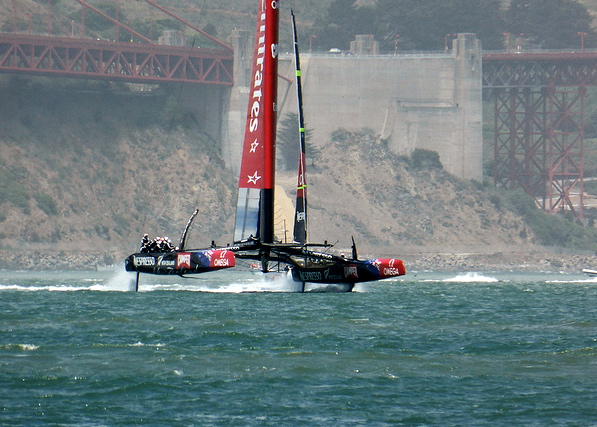Featured Stories | August 26, 2013
Inside the Fastest Boats in America’s Cup History with MIT MechE
By Genevieve Wanucha
“….It’s a clean start!” the America’s Cup commentator shouted yesterday. “And the Kiwis take the lead!” Two sailboats blasted through a foggy San Francisco Bay, dueling for a chance to race against the defending champion Oracle Team USA. Minutes later, Emirates Team New Zealand sailed to victory past Italy’s Luna Rossa Challenge, and now wait to confront their formidable rival in the finals on September 7.
The America’s Cup is the world’s oldest sporting trophy, backed by 162 years of sailing tradition. This year’s motto hints of something new: ‘Best Sailors. Fastest Boats.’ After winning the last cup in Valencia, Spain, in 2010, Larry Ellison, the billionaire entrepreneur and the owner of Oracle Team USA, pushed to reinvent the competition into a spectacular television-friendly event. He got his way—big time. The 2013 America’s Cup is now taking place much closer to the shore, within view of cheering spectators, music concerts, and grandstands. The biggest change is the newfangled boat design.
The new yacht, called the AC72 (America’s Cup 72 class), is unlike any sailboat that’s ever raced in an America’s Cup. The 72-foot-long, wing-sailed catamaran can travel more than twice as fast as the boats that competed in 2010. When the slick carbon-fiber crafts really get going, both hulls levitate out of the water and begin to fly over the surface on retractable underwater appendages called hydrofoils. The decrease in drag during foiling mode can boost the yacht’s speed past 45 knots, or 52 miles per hour. “It’s surreal,” says Team New Zealand’s wing trimmer Glenn Ashby.

Several professors in MIT’s Department of Mechanical Engineering, experts in naval architecture, marine hydrodynamics, and fluid mechanics, know a thing or two about sailboat design. Some have led the design of past U.S. America’s Cup boats. And they say that these AC72s have sailed straight into a new frontier in advanced marine technology. So, Oceans at MIT invited professors Doug Hart, Paul Sclavounos, and Jerome Milgram to answer a few questions about the fastest yachts in America’s Cup history. Knowing what they know will change the way you watch the race.
What makes the AC72 catamarans so fast and unique?
 Doug Hart, MIT S.M ’85 PhD ’93 (Cal Tech) , Professor of Mechanical Engineering. Interests: Fluid Mechanics, Optical Diagnostics, Tribology.
Doug Hart, MIT S.M ’85 PhD ’93 (Cal Tech) , Professor of Mechanical Engineering. Interests: Fluid Mechanics, Optical Diagnostics, Tribology.
“In order to counter the side force generated by the sails, boats must have a wing shape below the water that generates a force in the opposite direction. Catamarans use long thin rudders and hydrofoils near the center of the hull called daggerboards. The AC72’s are unique in that they have rudders and daggerboards designed to push up on the hulls and lift them out of the water while, at the same time, countering the sideways force of the sails.
In addition, AC72s use “wing” sails rather than the typical canvas sails you see on most sailboats. These are structures built very much like the wings of an airplane. They are “monocoque”-type structures, which means that part of the load is carried by the outer skin. This support allows the sails to be very thin and ridged. This design provides a means of controlling and optimizing the shape of the sails in ways that traditional canvas sails can not be controlled or optimized.
Finally, as with all catamarans, the hulls are long and thin. The force on the sails acting to flip the boat is countered by the weight of the crew and the weight of the part of the boat that is upwind of the sail. The two hulls of catamarans can be separated by considerable distances providing significant leverage against flipping. The long thin hulls also generate little wave drag (drag caused by the generation of waves by the boat itself) and help to pierce oncoming ocean waves rather than slamming into them and decelerating the boat.”
Designing innovative yachts must involve a great amount of fluid mechanics or marine hydrodynamics. What specific research areas are critical for this kind of sailboat design?
Paul Sclavounos, MIT PhD ’81, Professor of Mechanical Engineering and Naval Architecture. Interests: Marine Hydrodynamics, Marine & Mechanical Engineering. Professor Sclavounos has been a design contributor to three America’s Cup syndicates.
“The design of the new AC72 boats is a complex process lying at the intersection of a number of disciplines; marine hydrodynamics, aerodynamics, structural mechanics, advanced composites, and optimization theory. Of these disciplines the ones that are critical for the design of AC72 boats are marine hydrodynamics, aerodynamics and carbon fiber composites. The fluid dynamics involved in the design of the AC72 boat may now he handled reliably by computer programs that solve the Reynolds Averaged Navier Stokes Equations reducing the need for extensive tank and wind tunnel testing.”
Jerome Milgram, MIT PhD ’65, Professor of Mechanical and Ocean Engineering, William I. Koch Professor of Marine Technology, Emeritus. Professor Milgram has been a design contributor to more than eight America’s Cup syndicates.
“For the hydrofoil boats, called foilers, the fluid mechanics of lift is paramount. It differs from the lift of airplanes in that there is a free surface (water) very close to the foils, whereas an airplane lifts in nearly an infinite fluid (air). Lift in the presence of a free surface is the new field of fluid mechanics for foiling boats. In an ordinary boat, there is lift in the form of side force generated to counterbalance the side force of the sails. However, most of the lifting surface of an ordinary sailboat (the downward-projecting centerboard) is further from the free surface than is the case with a foiler, on which most of the underwater appendage is horizontal and close to the free surface. (See this video: Hydrofoils: Flying on Water)
The new AC boats have rigid wings instead of fabric sails. Their elliptical leading edges can have a suction force on them, which cancels out much of the drag. Thus, the drag coefficient of a rigid wing can be much lower than the drag coefficient of a sail. Furthermore, rigid wings can withstand small areas of pressure difference reversal that would cause an ordinary sail to luff, or flap. This increases in the amount of available control of the lift distribution.”
Doug Hart:
“Sailing yacht design is extremely complex. Sailboats are anything but simple – generally far more complex then airplanes. They are a balance of compromises between rules governing their construction, structural properties of the materials they are made from, wind and water forces, crew safety, and the controls needed to operate them. While a tremendous amount of modern technology and numerical modeling goes into the designs of these yachts, much of their design is based on practical experience, experimentation, and trial and error. Sailboat races are often won by fractions of a percent difference in overall speed. These differences can be the result of the ability to out maneuver the other boat, point slightly higher into the wind or any number of other factors. Such tiny differences are very difficult to account for by simple numerical modeling thus, yacht design is still very much an art.”
Are there any downsides to this AC design?
Jerome Milgram:
The interaction of a high speed boat with waves is different than the wave interaction of an ordinary low speed boat. When an AC boat traveling at high speeds has its bow hit a wave, the wave can cause an instantaneous increase in drag, slowing the boat with the air wing force and the inertial force of the boat slowing down can cause the boat to pitch pole. Unfortunately, there has been one death due to this kind of inertial and hydrodynamic interaction between the boat and sea waves.
There is some criticism of this departure from tradition and of the increased danger associated with the new design. But, others are excited to see this as more of a spectator sport and demonstration of futuristic technology. What is your personal reaction to this sea change in the America’s Cup?
Paul Sclavounos:
“There is a long and illustrious history of Americas’ Cup mono-hull yachts and many are nostalgic of this tradition. The innovations introduced under the IACC rule have led to outstanding boats that had almost exhausted every corner of the rule, leading to margins of victory often less than a minute for a three-hour race. The new Americas’ Cup rule represents an evolution that is, in a sense, a consequence of the maturity of the designs developed under the previous rule.
The design of the AC72 yachts draws upon advanced marine technologies, e.g. computational fluid dynamics and advanced composites, increasingly used for the design of other marine structures, e.g. fuel-efficient ships, composite mooring systems for offshore platforms and multi-megawatt offshore wind turbines. As has been the case in the past, the races of new AC72 boats will be exciting, and they stand to raise an awareness of the importance of technology in the design of advanced marine vehicles. As to the dangers associated with the new design, it is a risk that is hopefully small yet to a certain degree inevitable given that a new frontier in yachting is being explored.”
Jerome Milgram:
“I see both sides of this issue and each has merit. The boats do depart from tradition and are certainly dangerous, but they have the thrill of very high speed. I would not personally get on one of these boats. I have too much sense for that. Others see it differently.”
Doug Hart:
“While safety is certainly a major concern, as an engineer, I find these new yacht designs extremely exciting. My own feeling is that the America’s Cup races became too bogged down in rules and lost sight of what made them exciting. I hope these new yachts spark people’s imagination and usher in a new generation of young sailing enthusiasts.”








